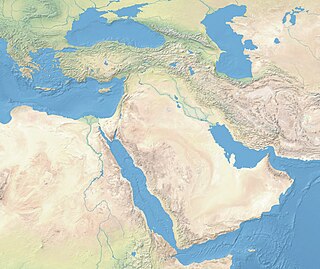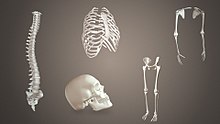Kennewick Man and Ancient One are the names given to the skeletal remains of a prehistoric Paleoamerican man found on a bank of the Columbia River in Kennewick, Washington, on July 28, 1996. It is one of the most complete ancient skeletons ever found. Radiocarbon tests on bone have shown it to date from 8,900 to 9,000 calibrated years before present, but it was not until 2013 that ancient DNA analysis techniques had improved enough to shed light on the remains.

Forensic anthropology is the application of the anatomical science of anthropology and its various subfields, including forensic archaeology and forensic taphonomy, in a legal setting. A forensic anthropologist can assist in the identification of deceased individuals whose remains are decomposed, burned, mutilated or otherwise unrecognizable, as might happen in a plane crash. Forensic anthropologists are also instrumental in the investigation and documentation of genocide and mass graves. Along with forensic pathologists, forensic dentists, and homicide investigators, forensic anthropologists commonly testify in court as expert witnesses. Using physical markers present on a skeleton, a forensic anthropologist can potentially determine a person's age, sex, stature, and race. In addition to identifying physical characteristics of the individual, forensic anthropologists can use skeletal abnormalities to potentially determine cause of death, past trauma such as broken bones or medical procedures, as well as diseases such as bone cancer.
Coffin birth, also known as postmortem fetal extrusion, is the expulsion of a nonviable fetus through the vaginal opening of the decomposing body of a deceased pregnant woman due to increasing pressure from intra-abdominal gases. This kind of postmortem delivery occurs very rarely during the decomposition of a body. The practice of chemical preservation, whereby chemical preservatives and disinfectant solutions are pumped into a body to replace natural body fluids, have made the occurrence of "coffin birth" so rare that the topic is rarely mentioned in international medical discourse.
Osteology is the scientific study of bones, practised by osteologists. A subdiscipline of anatomy, anthropology, and paleontology, osteology is the detailed study of the structure of bones, skeletal elements, teeth, microbone morphology, function, disease, pathology, the process of ossification, and the resistance and hardness of bones (biophysics).
A body farm is a research facility where decomposition of humans and other animals can be studied in a variety of settings. The initial facility was conceived by anthropologist William M. Bass in 1981 at the University of Tennessee in Knoxville, Tennessee, where Bass was interested in studying the decomposition of a human corpse from the time of death to the time of decay. The aim was to gain a better understanding of the decomposition process, permitting the development of techniques for extracting information such as the timing and circumstances of death from human remains. Body farm research is of particular interest in forensic anthropology and related disciplines, and has applications in the fields of law enforcement and forensic science. By placing the bodies outside to face the elements, researchers are able to get a better understanding of the decomposition process.
The term bioarchaeology has been attributed to British archaeologist Grahame Clark who, in 1972, defined it as the study of animal and human bones from archaeological sites. Redefined in 1977 by Jane Buikstra, bioarchaeology in the United States now refers to the scientific study of human remains from archaeological sites, a discipline known in other countries as osteoarchaeology, osteology or palaeo-osteology. Compared to bioarchaeology, osteoarchaeology is the scientific study that solely focus on the human skeleton. The human skeleton is used to tell us about health, lifestyle, diet, mortality and physique of the past. Furthermore, palaeo-osteology is simple the study of ancient bones.
The Robert J. Terry Anatomical Skeletal Collection is a collection of some 1,728 human skeletons held by the Department of Anthropology of the National Museum of Natural History of the Smithsonian Institution, Washington, D.C., United States.

Forensic facial reconstruction is the process of recreating the face of an individual from their skeletal remains through an amalgamation of artistry, anthropology, osteology, and anatomy. It is easily the most subjective—as well as one of the most controversial—techniques in the field of forensic anthropology. Despite this controversy, facial reconstruction has proved successful frequently enough that research and methodological developments continue to be advanced.

Jane Ellen Buikstra is an American anthropologist and bioarchaeologist. Her 1977 article on the biological dimensions of archaeology coined and defined the field of bioarchaeology in the US as the application of biological anthropological methods to the study of archaeological problems. Throughout her career, she has authored over 20 books and 150 articles. Buikstra's current research focuses on an analysis of the Phaleron cemetery near Athens, Greece.
FORDISC is a software program created by Stephen Ousley and Richard Jantz. It is designed to help forensic anthropologists investigate the identity of a deceased person by providing estimates of the person's size, ethnicity, and biological sex based on the osteological material recovered.
The University of Tennessee Anthropological Research Facility, better known as the Body Farm and sometimes seen as the Forensic Anthropology Facility, was conceived in 1971 and established in 1972 by anthropologist William M. Bass as the first facility for the study of decomposition of human remains. It is located a few miles from downtown Knoxville, Tennessee, US, behind the University of Tennessee Medical Center, and is part of the Forensic Anthropology Center, which was established by Dr. Bass in 1987.
Richard L. Jantz is an American anthropologist. He served as the director of the University of Tennessee Anthropological Research Facility from 1998–2011 and he is the current Professor Emeritus of the Department of Anthropology at the University of Tennessee, Knoxville. His research focuses primarily on forensic anthropology, skeletal biology, dermatoglyphics, anthropometry, anthropological genetics, and human variation, as well as developing computerized databases in these areas which aid in anthropological research. The author of over a hundred journal articles and other publications, his research has helped lead and shape the field of physical and forensic anthropology for many years.

Douglas W. Owsley is an American anthropologist who is head of Physical Anthropology at the Smithsonian's National Museum of Natural History (NMNH). He is regarded as one of the most prominent and influential archaeologists and forensic anthropologists in the world in some popular media. In September 2001, he provided scientific analysis at the military mortuary located at Dover Air Force Base, following the 9/11 attack in Washington, D.C. The following year, the US Department of Defense honored him with the Commander's Award for Civilian Service for helping in the identification of 60 federal and civilian victims who died when American Airlines Flight 77 hit the Pentagon.

Ata is the common name given to the 6-inch (15 cm) long skeletal remains of a human fetus found in 2003 in a deserted Chilean town in the Atacama Desert. DNA analysis done in 2018 on the premature human fetus identified unusual mutations associated with dwarfism and scoliosis, though these findings were later disputed. The remains were found by Oscar Muñoz, who later sold them; the current owner is Ramón Navia-Osorio, a Spanish businessman.
Osteoware is a free data recording software for human skeletal material that is managed through the Smithsonian Museum of Natural History. It is used by biological anthropologists to document data relevant to research and forensic applications of human skeletal remains in a standardized and consistent way. It has influenced other skeletal recording software, and has been successfully used at the Smithsonian for collecting data relevant to biological anthropology. Osteoware is the only free, individual-use software for the collection of data on skeletal material in anthropology.
Mortuary archaeology is the study of human remains in their archaeological context. This is a known sub-field of bioarchaeology, which is a field that focuses on gathering important information based on the skeleton of an individual. Bioarchaeology stems from the practice of human osteology which is the anatomical study of skeletal remains. Mortuary archaeology, as well as the overarching field it resides in, aims to generate an understanding of disease, migration, health, nutrition, gender, status, and kinship among past populations. Ultimately, these topics help to produce a picture of the daily lives of past individuals. Mortuary archaeologists draw upon the humanities, as well as social and hard sciences to have a full understanding of the individual.

Erin H. Kimmerle is an American forensic anthropologist, artist, and executive director of the Institute of Forensic Anthropology & Applied Science at the University of South Florida. She was awarded the 2020 AAAS Award for Scientific Freedom and Responsibility.
Lucile Eleanor St. Hoyme was an American biological anthropologist who conducted research related to human variation, bioarcheology, and paleopathology. St. Hoyme served as an Assistant Curator in the Department of Anthropology at the National Museum of Natural History. St. Hoyme analyzed human remains excavated from the John Kerr Reservoir Basin using a new bioarcheological approach combining data from other disciplines. Beyond her work with the Smithsonian collections, St. Hoyme also worked on FBI forensic cases in the 1960s with National Museum of Natural History Anthropology Curator J. Lawrence Angel.
The stages of death of a human being have medical, biochemical and legal aspects. The term taphonomy from palaeontology applies to the fate of all kinds of remains of organisms. Forensic taphonomy is concerned with remains of the human body.

Near Eastern bioarchaeology covers the study of human skeletal remains from archaeological sites in Cyprus, Egypt, Levantine coast, Jordan, Turkey, Iran, Saudi Arabia, Qatar, Kuwait, Bahrain, United Arab Emirates, Oman, and Yemen.









